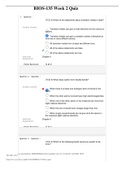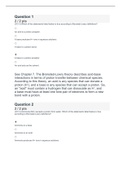BIOS 135
Devry University-Chicago
All 3 results
Sort by
BIOS 135/BIOS135 MIDTERM EXAM (NEW UPDATE ) WITH STANDARD Q&A GUARANTEED A+

-
BIOS-135 Week 2 Quiz (Multiple Choice & Short Questions)/ 100% Guaranteed Pass
- Exam (elaborations) • 2 pages • 2022
-
 ProfGoodlucK
ProfGoodlucK
-
- $10.99
- + learn more
1. Question : (TCO 3) Which of the statements about transition metals is false? Student Answer: Transition metals can gain or lose electrons to form anions or cations. Transition metals can gain a variable number of electrons to form two or more different anions. All transition metals form at least two different ions. All of the above statements are false. All of the above statements are true. Instructor Chapter 4 Explanation: Points Received: 0 of 2 Comments: Question 2. Question : (TCO 3) When...

-
BIOS 135 Week 3 Quiz (Latest Version) Questions with Answers.
- Exam (elaborations) • 13 pages • 2021
-
 TESTSOURCE
TESTSOURCE
-
- $15.40
- + learn more
Question 1 2 / 2 pts (CO 3) Which of the statements listed below is true according to Bronsted-Lowry definitions? An acid is a proton acceptor. A base produces H+ ions in aqueous solutions. A base is a proton donor. Correct! A base is a proton acceptor. An acid acts as the solvent. See Chapter 7. The Brønsted-Lowry theory describes acid-base interactions in terms of proton transfer between chemical species. According to this theory, an acid is any species...

$6.50 for your textbook summary multiplied by 100 fellow students... Do the math: that's a lot of money! Don't be a thief of your own wallet and start uploading yours now. Discover all about earning on Stuvia



